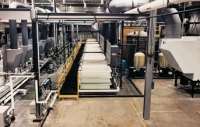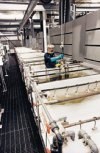Meeting Strict Plating Specifications
Plating critical components with the help of new tank technology...
Boeing Precision Gear, Bedford Park, Illinois, manufactures new and rebuilt transmissions for the CH-46 "Seanight" and CH-47 "Chinook" military helicopters. Plating on these components is critical. If the plating does not meet lubricity potential, abrasion/corrosion resistance or stop-off specifications, catastrophic failures can occur.
The plating operations performed at Boeing include hard chromium, cadmium, copper, nickel, tin and Alodine (an aluminum chromate conversion coating). The company also does stainless passivation, black oxiding, pickling, magnesium dichromate and Nital etch at this facility.
Featured Content
Eighty process tanks are situated on four parallel process lines in a special configuration developed by Walgren Co., Grand Rapids, Michigan. It is a primary supplier to Boeing and was selected to design and build the lines following the successful start-up of phosphoric acid anodizing lines at Boeing's helicopter assembly facility in Philadelphia, Pennsylvania. Currently, the Philadelphia facility is installing its second line.
The system designer fabricated 15 stainless-steel tanks for black oxiding, paraffin masking and other uses. The remaining 65 tanks, all high-strength one-inch polypropylene, were manufactured by Tri-Mer Corp., Owosso, Michigan.
Included in the tank manufacturing process are programmable, high-temperature, high-pressure extrusion welding devices that create maximum corner and seam strength. Also included is a fabrication protocol that eliminates corner welds and structural compromising areas, a plating system that distributes mechanical stresses with exceptional uniformity and a structural support cradling that eliminates distortion from even the largest tanks.
The tank manufacturer's responsibilities for the Boeing program also included the design and manufacture of individual tank hoods, ventilation and ducting. The engineering of the ventilation system was particularly challenging due to numerous construction obstacles and its siting on a specially constructed mezzanine. Ducting was manufactured from one-quarter-inch PVC. Walgren designed and built the system's in-tank air agitation, tank heating systems and cooling and filtration devices.
The five scrubber systems that serve Boeing's four process lines were engineered and built by the tank manufacturer. The scrubber system has an 11,800-cfm CE-140 chromium eliminator that exclusively handles chromium emissions. This all-mechanical system consistently removes both hexavalent and trivalent chromium particulates without chemicals. It is 99 to 99.9 pct efficient, regardless of the input loading, and comfortably meets the 0.006 mg/amp/hr chromium emission maximum established by EPA.
The chromium eliminator is special because it has no internal moving parts to wear or replace and continuously recovers chromium from both the gas stream and the filter. Its dispersion media filter can be reused indefinitely. Water requirements for the chromium eliminator are low. Average consumption is 15 gph in a 20,000-cfm unit.
The remaining Boeing scrubbers are Crossflows in capacities ranging from 18,000 to 36,000 cfm. These units scrub all major inorganics. Stack emissions are maintained at low ppm regardless of the input concentration. One reason for the system's high performance is an accelerated liquid recirculation system, which creates intense, continuous contact between the scrubbing liquid and contaminant.
The Crossflows use spherical Tri-Pack tower packing. This packing media, which is proprietary to the tank manufacturer's system, facilitates maximum continuous droplets within the scrubber and develops a low static pressure per foot of depth. Therefore, it minimizes the packing depth required to achieve the desired removal efficiency. Also, the scrubbers have a series of specially designed mist eliminators that perform at greater than 99-pct efficiency at 10 microns. This allows them to eliminate droplet carry-through from the fan to the stack. The scrubbers installed at Boeing receive fumes in the ambient temperature range.
At Boeing, one scrubber system is dedicated to cyanide emissions from copper and cadmium plating while the remaining four systems handle other acid and alkaline emissions. The scrubbers operate with zero production interruption, because critical system component modules have full back-up. Back-up readiness is assured through regular hand-over from primary systems. This reduces both monitoring and maintenance and assures full performance, even during normal maintenance.
The engineering and manufacture of the wastewater treatment system was the responsibility of the turnkey system supplier. This batch system separates rinse waters from 40 tanks into alkaline, cyanide and acid chromium waste streams. The system adjusts effluent pH and adds sodium hypochlorite to the cyanide and sodium bisulfite to the chromium for reduction.
When metal hydroxides precipitate out, clear supernate is decanted to the final tank. The sludge is pumped to a 6,400-gal sludge concentrator. A five-cu-ft filter press (which is engineered in double capacity) creates the dry solid taken to landfill.
The system design used Boeing's existing concrete floor, adding trenches and curbing to separate the chromium and cyanide processing areas. Drains and overflows are hard-piped to polypropylene sump tanks. Thus, the only liquid contacting the concrete is maintenance washdown and dragout, which is pumped to the appropriate waste treatment area.
Tanks are side-marked for optimum fill level, including reagent chemicals. When a batch is ready to treat, the operator diverts the flow to the empty tank. Alarms alert the operator if tank levels approach freeboard set points.
Six chemicals (sodium hypochlorite, caustic soda, calcium chloride, flocculant, sulfuric acid and bisulfite) are delivered to the treatment tanks by M-1 double-diaphragm air pumps. The system delivers chemicals at the same rate, regardless of viscosity. A panel details system activity and indicates levels for treatment tanks, sump tanks and concrete containment surrounding the sump.
Among the individual controls serving the system are conductivity sensors positioned adjacent to the steam coils. If the conductivity rises too high in the condensate lines prior to entering the condensate receiver, a valve diverts condensate to the appropriate sump rather than back to the boiler. If, for example, a heated acid tank develops a leak, sensors will pick up solution in the condensate and divert it to waste treatment. Other indicators on the waste treatment panel monitor the recirculation systems on the five ventilation scrubbers.
All treatment tanks on the line have three-valve decant fittings on the sides at various levels that allow the operator to determine sludge and supernate depths. All pumps and mixers are controlled using selector switches at the waste treatment panel on the catwalk, except for the filter press and filter press feed pump, which are best controlled from the floor where actual inspection can occur.
Boeing has invested in some of the industry's most advanced and important technology to assure the long-term success and flexibility of its Bedford Park plant
RELATED CONTENT
-
Stripping of Plated Finishes
The processes, chemicals and equipment, plus control and troubleshooting.
-
Smut and Desmutting
Question: I am new to this industry and have heard about smut and desmutting operations.
-
Choosing and Troubleshooting Copper Electroplating Processes
Learn more on this inexpensive and highly efficient process.





















